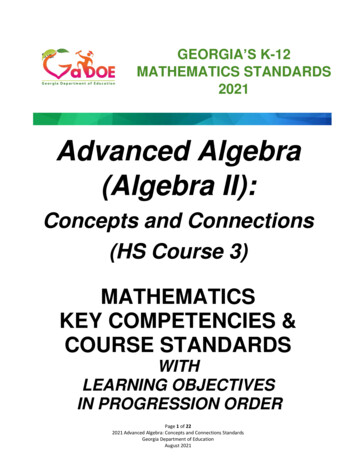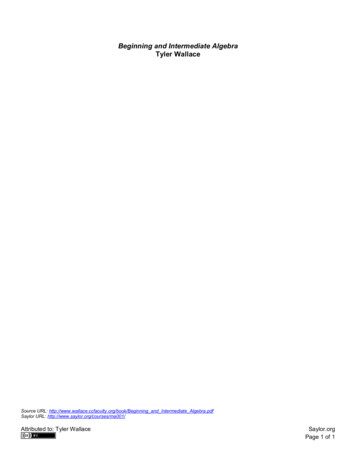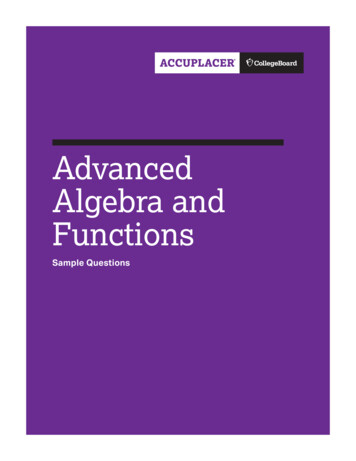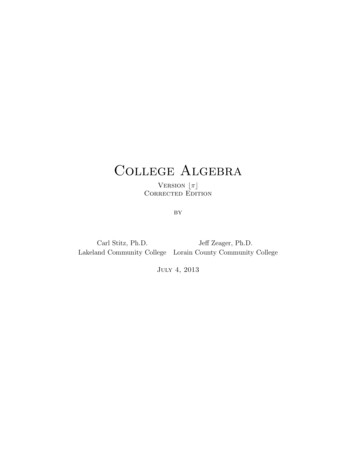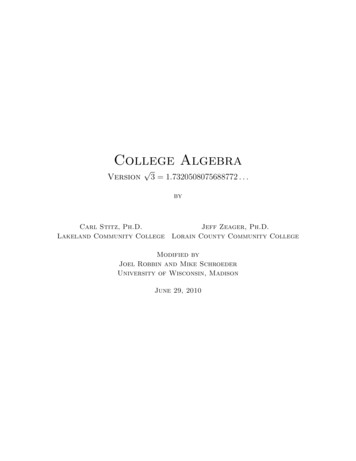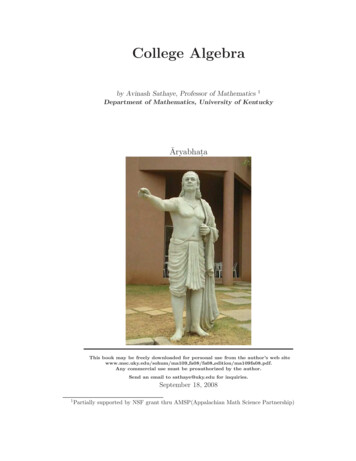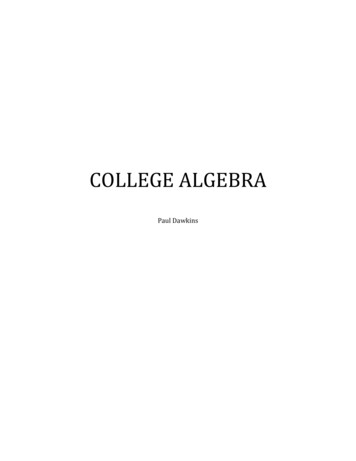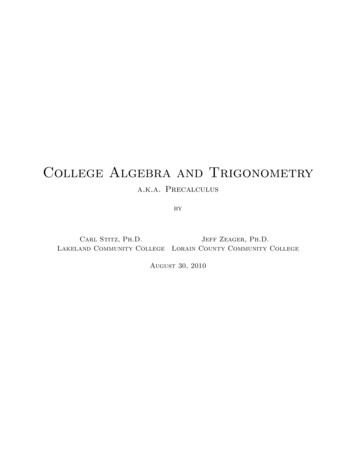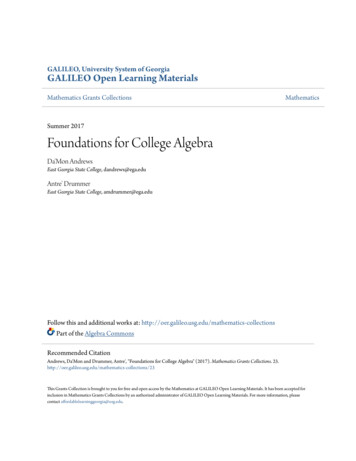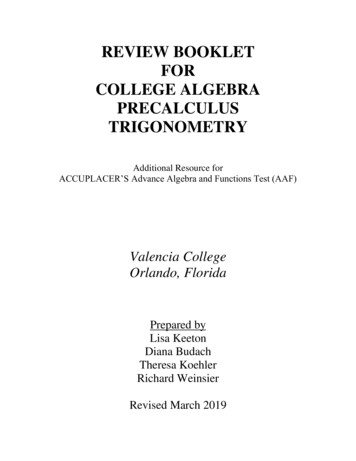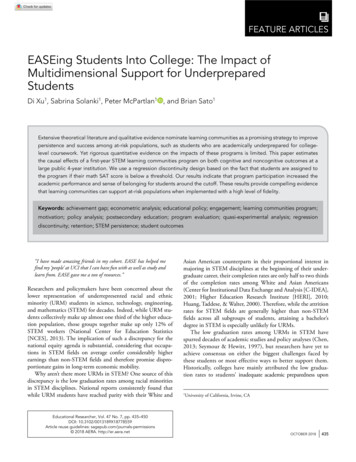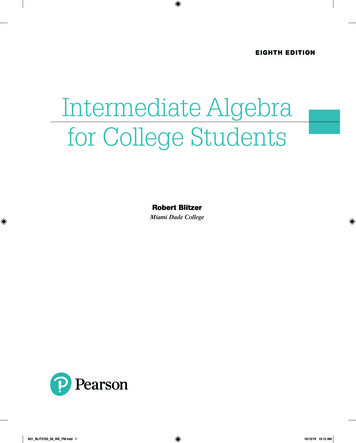
Transcription
EI GHT H ED I T I ONIntermediate Algebrafor College StudentsAnnotated Instructor’s EditionRobert BlitzerMiami Dade CollegeA01 BLIT3700 08 AIE FM.indd 116/12/19 10:12 AM
Please contact pport with any queries on this contentCopyright 2021, 2017, 2013 by Pearson Education, Inc. or its affiliates, 221 River Street, Hoboken, NJ07030. All Rights Reserved. Printed in the United States of America. This publication is protected bycopyright, and permission should be obtained from the publisher prior to any prohibited reproduction,storage in a retrieval system, or transmission in any form or by any means, electronic, mechanical, photocopying, recording, or otherwise. For information regarding permissions, request forms and the appropriate contacts within the Pearson Education Global Rights & Permissions department, please s of third party content appear on page C1, which constitutes an extension of this copyright page.PEARSON, ALWAYS LEARNING, and MYLAB are exclusive trademarks owned by Pearson Education,Inc. or its affiliates in the U.S. and/or other countries.Unless otherwise indicated herein, any third-party trademarks that may appear in this work are the propertyof their respective owners and any references to third-party trademarks, logos or other trade dress are fordemonstrative or descriptive purposes only. Such references are not intended to imply any sponsorship,endorsement, authorization, or promotion of Pearson’s products by the owners of such marks, or anyrelationship between the owner and Pearson Education, Inc. or its affiliates, authors, licensees or distributors.Library of Congress Control Number: 2019919033Cataloging-in-Publication Data is available on file at the Library of Congress.Access Code CardISBN-10: 0136553885ISBN-13: 9780136553885RentalISBN-10: 0136553435ISBN-13: 9780136553434A01 BLIT3700 08 AIE FM.indd 216/12/19 10:12 AM
Table of ContentsPreface viiMid-Chapter Check Point—Section 2.1–Section 2.3 135To the Student xv2.4 Linear Functions and Slope 136About the Author xvii2.5 The Point-Slope Form of the Equation of a Line 155Chapter 2 Summary 1681Algebra, Mathematical Models, andProblem Solving 1Chapter 2 Review Exercises 172Chapter 2 Test 174Cumulative Review Exercises (Chapters 1–2) 1761.1 Algebraic Expressions, Real Numbers, and IntervalNotation 21.2 Operations with Real Numbers and Simplifying AlgebraicExpressions 151.3 Graphing Equations 301.4 Solving Linear Equations 40Mid-Chapter Check Point—Section 1.1–Section 1.4 531.5 Problem Solving and Using Formulas 541.6 Properties of Integral Exponents 701.7 Scientific Notation 82Chapter 1 Summary 92Chapter 1 Review Exercises 97Chapter 1 Test 1012Functions andLinear Functions 1032.1 Introduction to Functions 1042.2 Graphs of Functions 1142.3 The Algebra of Functions 125iiiA01 BLIT3700 08 AIE FM.indd 316/12/19 10:12 AM
iv Table of Contents3Systems ofLinear Equations 1773.1 Systems of Linear Equations in Two Variables 1783.2 Problem Solving and Business Applications UsingSystems of Equations 1943.3 Systems of Linear Equations in Three Variables 2084.4 Linear Inequalities in Two Variables 2874.5 Linear Programming 298Chapter 4 Summary 306Chapter 4 Review Exercises 308Chapter 4 Test 310Cumulative Review Exercises (Chapters 1–4) 311Mid-Chapter Check Point—Section 3.1–Section 3.3 2203.4 Matrix Solutions to Linear Systems 2213.5 Determinants and Cramer’s Rule 232Chapter 3 Summary 242Chapter 3 Review Exercises 248Chapter 3 Test 250Cumulative Review Exercises (Chapters 1–3) 2514Inequalities andProblem Solving 2534.1 Solving Linear Inequalities 2544.2 Compound Inequalities 2664.3 Equations and Inequalities Involving Absolute Value 275Mid-Chapter Check Point—Section 4.1–Section 4.3 2865Polynomials, PolynomialFunctions, and Factoring 3135.1 Introduction to Polynomials and PolynomialFunctions 3145.2 Multiplication of Polynomials 3285.3 Greatest Common Factors and Factoringby Grouping 3415.4 Factoring Trinomials 350Mid-Chapter Check Point—Section 5.1–Section 5.4 3635.5 Factoring Special Forms 3645.6 A General Factoring Strategy 3745.7 Polynomial Equations and Their Applications 381Chapter 5 Summary 395Chapter 5 Review Exercises 398Chapter 5 Test 401Cumulative Review Exercises (Chapters 1–5) 4026Rational Expressions, Functions,and Equations 4036.1 Rational Expressions and Functions: Multiplyingand Dividing 4046.2 Adding and Subtracting Rational Expressions 4186.3 Complex Rational Expressions 4306.4 Division of Polynomials 438Mid-Chapter Check Point—Section 6.1–Section 6.4 447A01 BLIT3700 08 AIE FM.indd 416/12/19 10:12 AM
Table of Contents v6.5 Synthetic Division and the Remainder Theorem 4486.6 Rational Equations 4556.7 Formulas and Applications of Rational Equations 4666.8 Modeling Using Variation 479Chapter 6 Summary 491Chapter 6 Review Exercises 496Chapter 6 Test 499Cumulative Review Exercises (Chapters 1–6) 50079Exponential and LogarithmicFunctions 6619.1 Exponential Functions 6629.2 Composite and Inverse Functions 6769.3 Logarithmic Functions 6919.4 Properties of Logarithms 704Mid-Chapter Check Point—Section 9.1–Section 9.4 7159.5 Exponential and Logarithmic Equations 7169.6 Exponential Growth and Decay; Modeling Data 731Radicals, Radical Functions,and Rational Exponents 5017.1 Radical Expressions and Functions 5027.2 Rational Exponents 515Chapter 9 Summary 744Chapter 9 Review Exercises 749Chapter 9 Test 753Cumulative Review Exercises (Chapters 1–9) 7557.3 Multiplying and Simplifying Radical Expressions 5257.4 Adding, Subtracting, and Dividing RadicalExpressions 533Mid-Chapter Check Point—Section 7.1–Section 7.4 5417.5 Multiplying with More Than One Term and RationalizingDenominators 5427.6 Radical Equations 5527.7 Complex Numbers 562Chapter 7 Summary 572Chapter 7 Review Exercises 576Chapter 7 Test 578Cumulative Review Exercises (Chapters 1–7) 5798Quadratic Equationsand Functions 5818.1 The Square Root Property and Completingthe Square 5828.2 The Quadratic Formula 5968.3 Quadratic Functions and Their Graphs 611Mid-Chapter Check Point—Section 8.1–Section 8.3 6298.4 Equations Quadratic in Form 6308.5 Polynomial and Rational Inequalities 638Chapter 8 Summary 653Chapter 8 Review Exercises 657Chapter 8 Test 659Cumulative Review Exercises (Chapters 1–8) 660A01 BLIT3700 08 AIE FM.indd 516/12/19 10:12 AM
vi Table of Contents10Conic Sections and Systemsof Nonlinear Equations 75710.1 Distance and Midpoint Formulas; Circles 75810.2 The Ellipse 76810.3 The Hyperbola 780Mid-Chapter Check Point—Section 10.1–Section 10.3 78910.4 The Parabola; Identifying Conic Sections 79010.5 Systems of Nonlinear Equations in Two Variables 802Chapter 10 Summary 813Chapter 10 Review Exercises 816Chapter 10 Test 818Cumulative Review Exercises (Chapters 1–10) 81811Sequences, Series, and theBinomial Theorem 82111.1 Sequences and Summation Notation 82211.2 Arithmetic Sequences 83211.3 Geometric Sequences and Series 842Mid-Chapter Check Point—Section 11.1–Section 11.3 85811.4 The Binomial Theorem 859Chapter 11 Summary 867Chapter 11 Review Exercises 869Chapter 11 Test 871Cumulative Review Exercises (Chapters 1–11) 872Appendix Where Did That Come From? SelectedProofs 873Answers to Selected Exercises AA1Applications Index I1Subject Index I7Photo Credits C1A01 BLIT3700 08 AIE FM.indd 616/12/19 10:12 AM
PrefaceIntermediate Algebra for College Students, Eighth Edition, provides comprehensive,in-depth coverage of the topics required in a one-term course in intermediate algebra.The book is written for college students who have had a course in introductoryalgebra or who have demonstrated proficiency in the objectives of such a course.I wrote the book to help diverse students with different backgrounds and career planssucceed in intermediate algebra. Intermediate Algebra for College Students, EighthEdition, has two primary goals:1. To help students acquire a solid foundation in the skills and concepts ofintermediate algebra needed for success in future STEM and non-STEM directedmath courses.2. To show students how algebra can model and solve authentic real-world problems.One major obstacle in the way of achieving these goals is the fact that very fewstudents actually read their textbook. This has been a regular source of frustrationfor me and for my colleagues in the classroom. Anecdotal evidence gathered overyears highlights two basic reasons students give when asked why they do not takeadvantage of their textbook: “I’ll never use this information.” “I can’t follow the explanations.”I’ve written every page of the Eighth Edition with the intent of eliminating these twoobjections. The ideas and tools I’ve used to do so are described in the features that follow.These features and their benefits are highlighted for the student in “A Brief Guide toGetting the Most from This Book,” which appears inside the front cover.What’s New in the Eighth Edition? New and Updated Applications and Real-World Data. The Eighth Edition containsmore than 100 new or revised worked-out examples and exercises based on updatedand new data sets. Many of these applications involve topics of interest to collegestudents and newsworthy items. Among topics of interest to college students, you’llfind data sets describing student loan debt (Section 1.1, Example 4), discretionaryspending among college students (Exercise Set 1.2, Exercises 147–148), cost of tuitionand fees at public four-year colleges (Section 1.4 opener; Section 1.4, Example 7), costof tuition and fees at private four-year colleges (Exercise Set 1.4, Exercises 67–68),earnings, by educational attainment (Section 1.5, Example 1 and Check Point 1),life objectives of college freshmen (Section 1.5, Example 2 and Check Point 2),percentage of college freshmen with no religious affiliation (Exercise Set 2.5,Exercises 69–70), high school students applying to more than three colleges(Exercise Set 9.1, Exercises 57–58), the percentage of college graduates amongAmericans 25 and older (Exercise Set 11.2, Exercises 61–62), and dormitory chargesat four-year colleges (Exercise Set 11.2, Exercises 65–66). Among newsworthy topicsviiA01 BLIT3700 08 AIE FM.indd 716/12/19 10:12 AM
viii Prefaceapplications include the percentage of the U.S. population using the Internet(Exercise Set 1.3, Exercises 47–52), taxes (Section 1.7 opener; Section 1.7, Example 5and Check Point 5), growing world population (Section 1.7, Example 3), support formarriage equality among Democrats and Republicans (Chapter 1 Review,Exercise 75), the number of U.S. prisoners (Chapter 1 Test, Exercise 8;Exercise Set 2.3, Exercises 63–65), U.S. births and deaths (Section 2.3 opener;Section 2.3, Example 5 and Check Point 5), overweight U.S. adults (Exercise Set 2.4,Exercises 85–86), the federal minimum wage (Exercise Set 2.4, Exercise 112),climate change (Chapter 2 Review, Exercise 60), employment, by gender(Exercise Set 3.1, Exercises 95–96), school bullying (Exercise Set 4.1, Exercises 57–58),diagnosed HIV cases (Section 5.1 opener), Amazon deforestation (Chapter 6Review, Exercise 91), and Americans giving up their citizenship, primarily for taxreasons (Exercise Set 11.1, Exercise 58). NEW! Animations created in GeoGebra help students visualize mathematical concepts through directed explorations and purposeful manipulation.Corresponding MyLab Math exercises allow these new animations to be assignedwith assessment to check for understanding. NEW! Integrated Review in MyLab Math can be used in a corequisite course orsimply to help students who enter their course without a full understanding ofprerequisite skills.Once the instructor has assigned the premade Integrated Review assignments, students begin each chapter by completing a Skills Check to pinpoint which prerequisite topics, if any, they need to review.Personalized review homework provides extra support for students who need it onjust the topics they did not master in the Skills Check.Additional review materials, including worksheets and videos, are available.What Familiar Features Have Been Retained in the EighthEdition of Intermediate Algebra for College Students? Learning Objectives. Learning objectives, framed in the context of a studentquestion (What am I supposed to learn?), are clearly stated at the beginning of eachsection. These objectives help students recognize and focus on the section’s mostimportant ideas. The objectives are restated in the margin at their point of use. Chapter-Opening and Section-Opening Scenarios. Every chapter and everysection open with a scenario presenting a unique application of mathematics instudents’ lives outside the classroom. These scenarios are revisited in the course ofthe chapter or section in an example, discussion, or exercise. Innovative Applications. A wide variety of interesting applications, supported byup-to-date, real-world data, are included in every section. Detailed Worked-Out Examples. Each example is titled, making the purpose ofthe example clear. Examples are clearly written and provide students with detailedstep-by-step solutions. No steps are omitted and each step is thoroughly explainedto the right of the mathematics. Explanatory Voice Balloons. Voice balloons are used in a variety of ways todemystify mathematics. They translate algebraic ideas into everyday English, helpclarify problem-solving procedures, present alternative ways of understandingconcepts, and connect problem solving to concepts students have already learned. Check Point Examples. Each example is followed by a similar matched problem,called a Check Point, offering students the opportunity to test their understandingof the example by working a similar exercise. The answers to the Check Points areprovided in the answer section. Concept and Vocabulary Checks. This feature offers short-answer exercises, mainlyfill-in-the-blank and true/false items, that assess students’ understanding of thedefinitions and concepts present
Intermediate Algebra for College Students, Eighth Edition, provides comprehensive, in-depth coverage of the topics required in a one-term course in intermediate algebra. The book is written for college students who have had a course in introductory algebra or who have demonstrated proficiency in the objectives of such a course. I wrote the book to help diverse students with different .

